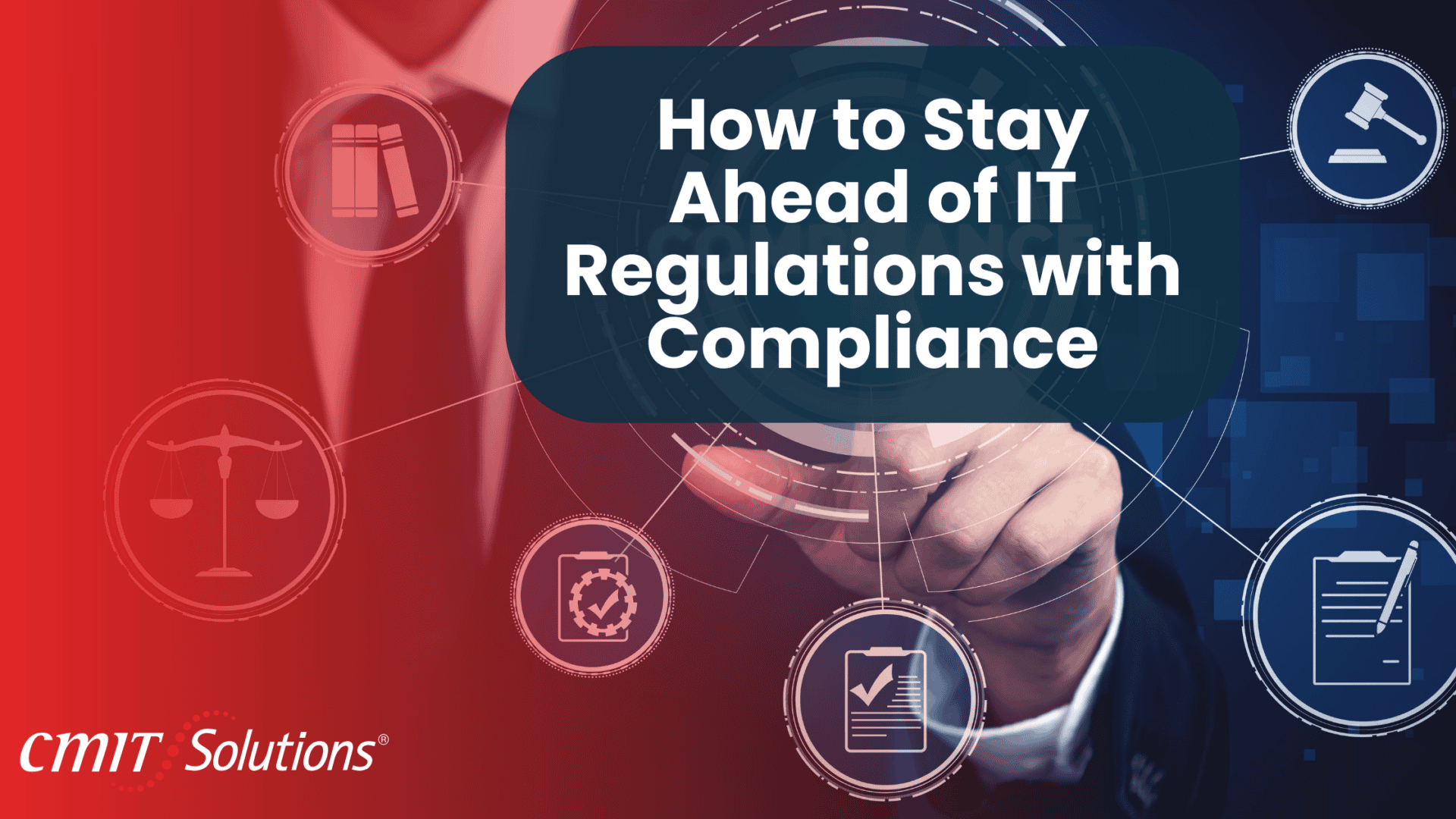- SMBs can stay ahead of IT regulations by conducting thorough assessments, monitoring regulatory changes, developing strong data management policies, and implementing robust cybersecurity measures. Partnering with experts and leveraging compliance technology simplifies the process.
- Regular employee training on compliance best practices and fostering a compliance-first mindset within the organization helps to minimize human error and reinforce accountability.
- Staying compliant not only avoids penalties but also builds trust with customers, enhances credibility, and provides a competitive edge, helping SMBs secure stronger stakeholder relationships and long-term growth.
With the business world becoming so engrained in digital spaces, businesses nowadays have to navigate IT regulations just to keep themselves running smoothly. For small and medium-sized businesses (SMBs), that includes staying compliant. Not only do SMBs need to avoid fines or legal trouble, but showing that they’re compliant can help build trust with customers while also staying competitive.
Compliance can seem overwhelming, especially for SMBs with limited resources. However, with the right strategies, you can not only meet regulatory demands but also turn compliance into a strength for your business.
The Importance of IT Compliance
IT compliance refers to adhering to laws, regulations, and industry standards that govern how businesses manage and protect data. Depending on your industry, you may need to comply with regulations like GDPR, HIPAA, or PCI DSS. These frameworks are designed to keep businesses that handle sensitive information secure and ethical.
For SMBs, non-compliance can lead to significant financial penalties, reputational damage, and even legal action. More importantly, failing to comply could result in data breaches, which could devastate your business. On the flip side, proactive compliance enhances trust with customers and partners as it shows that you take data protection seriously.
Start with a Thorough Assessment
The first step in staying ahead of IT regulations is knowing where you currently stand. As such, conduct a comprehensive compliance assessment to help you identify gaps and vulnerabilities in your processes. Review your data handling practices, cybersecurity measures, and documentation to determine how well they align with the regulations relevant to your industry.
Partnering with an IT consultant or using compliance management tools can make this process more manageable. These experts and tools will evaluate your systems and provide actionable insights into what needs improvement.
Keep Up with Regulatory Changes
Regulations evolve as technology advances and new threats emerge. Staying informed about changes to IT regulations is therefore important when it comes to staying compliant. Set up alerts for updates to laws and standards that impact your business. Regularly check government websites, industry news, and trusted compliance resources to stay informed.
Joining industry associations or subscribing to newsletters from regulatory bodies can also help you keep track of updates. Consider designating someone on your team to monitor regulatory changes so that your business doesn’t miss critical updates.
Develop a Thorough Data Management Policy
A strong data management policy is the backbone of IT compliance. This policy should outline how your business collects, stores, and protects sensitive information. Start by defining what constitutes sensitive data for your business. For example, this could include customer payment information, employee records, or proprietary business data.
Next, detail how this data will be stored, who will have access to it, and how it will be protected. Use encryption, secure backups, and restricted access to make sure sensitive information remains safe. Regularly review and update your data management policy to address new risks or changes in regulations.
Invest in Employee Training
Your employees play a vital role in maintaining compliance. Without proper training, even the strongest policies can fall apart due to human error. Regularly train your staff on the latest compliance requirements and best practices for data security.
Focus on topics like recognizing phishing attempts, creating strong passwords, and following your company’s data handling procedures. Training sessions don’t need to be lengthy or complicated. Short, interactive workshops or online modules can be highly effective in keeping your team informed and engaged.
Implement Strong Cybersecurity Measures
Cybersecurity and IT compliance go hand in hand. Many regulations require businesses to implement specific security measures, such as firewalls, antivirus software, and multi-factor authentication. These tools not only protect your data but also demonstrate your commitment to compliance.
Conduct regular risk assessments to identify potential vulnerabilities in your systems. Address these weaknesses promptly by updating software, patching systems, and reinforcing network security. Additionally, consider partnering with a managed IT service provider to keep your cybersecurity measures up to date.
Create and Maintain Comprehensive Documentation
Documentation is a cornerstone of compliance. Regulators often require businesses to provide detailed records of their data handling practices, security protocols, and employee training programs. By keeping thorough documentation, you can demonstrate your compliance efforts if you’re ever audited.
Start by creating a central repository for all your compliance-related documents. Include policies, training materials, risk assessment reports, and records of incidents or breaches. Make sure these documents are regularly updated and easily accessible to authorized personnel.
Conduct Regular Audits
Staying ahead of IT regulations requires ongoing effort. Regular compliance audits help make sure your business continues to meet regulatory requirements as they evolve. These audits should review your policies, procedures, and systems to identify areas for improvement.
Consider conducting both internal and external audits. Internal audits allow you to assess your compliance efforts independently, while external audits provide an objective evaluation from a third-party expert. Schedule these audits annually or whenever significant changes occur in your business or regulatory environment.
Leverage Technology to Simplify Compliance
Managing IT compliance manually can be time-consuming and error-prone, especially for SMBs. Fortunately, there are many technology solutions available to streamline the process.
Compliance management software can help you track regulatory requirements, monitor your systems, and generate reports with ease. Additionally, tools like data encryption software, intrusion detection systems, and secure communication platforms can enhance your compliance efforts. Choose solutions that align with your business’s specific needs and budget.
Foster a Culture of Compliance
Compliance isn’t just about policies and tools; it’s about mindset. Create a culture of compliance within your organization so that everyone understands its importance and works together to maintain it.
Start by making compliance a core value in your business. Communicate its importance to your team and lead by example. Recognize and reward employees who demonstrate a commitment to compliance, and address non-compliance issues promptly and constructively.
Stay Proactive, Not Reactive
One of the biggest mistakes SMBs make is waiting until a problem arises to address compliance. By that point, the damage may already be done. Instead, take a proactive approach to compliance. Regularly review your policies, train your staff, and update your systems to stay ahead of potential issues.
Being proactive also means planning for worst-case scenarios. Develop an incident response plan that outlines how your business will handle data breaches, regulatory audits, or other compliance-related challenges. Test this plan regularly to check that it’s effective and up to date.
Partner with Compliance Experts
If managing IT compliance feels overwhelming, consider partnering with experts who can guide you through the process. Compliance consultants, managed IT service providers, and legal advisors specialize in helping businesses navigate complex regulations. These professionals can provide tailored advice, implement best practices, and keep your business compliant with minimal disruption. While this requires an upfront investment, it can save you time, money, and stress in the long run.
The Business Benefits of Staying Compliant
Staying ahead of IT regulations offers more than just risk mitigation. It can also provide tangible business benefits. For example, demonstrating compliance can give you a competitive edge when bidding for contracts or attracting customers who value data security.
Moreover, compliance fosters trust and credibility with your stakeholders. Customers, partners, and investors are more likely to work with businesses that prioritize data protection and ethical practices. This trust translates into stronger relationships and long-term success.
Compliance As an Ongoing Journey
IT regulations will continue to evolve, and new challenges will emerge. You can successfully negotiate this challenging environment if you remain knowledgeable, proactive, and dedicated to compliance.
As an SMB, you have the opportunity to turn compliance into a strength rather than a burden. You can meet regulatory requirements and create a more robust and resilient business in the future by incorporating it into your business plan and cultivating an accountable culture.
Building Relationships with Regulators
One often overlooked aspect of staying ahead in IT compliance is developing positive relationships with regulatory bodies. For SMBs, reaching out to these organizations can feel intimidating, but it can be incredibly beneficial. Many regulators offer resources, guidance, and even workshops to help businesses understand and meet compliance requirements.
Engaging with regulators proactively demonstrates your commitment to compliance and can help you clarify ambiguous requirements. If you’re unsure about a particular aspect of a regulation, don’t hesitate to ask for guidance. Being transparent about your efforts and challenges can lead to valuable insights and even leniency in the event of minor compliance lapses.
Consider attending industry conferences where regulators are present or participating in webinars and panels discussing compliance trends. Building these connections not only keeps you informed but also positions your business as one that prioritizes regulatory alignment.
The Role of Third-Party Certifications
Another strategy to strengthen your compliance efforts is obtaining relevant third-party certifications. These certifications, such as ISO 27001 for information security or SOC 2 for service organizations, provide external validation of your compliance practices.
Achieving these certifications often involves rigorous audits and assessments, but the process can significantly enhance your business’s security posture. Certifications serve as a seal of trust, reassuring customers, partners, and stakeholders that your business meets high standards of data protection and operational security.
Beyond the immediate benefits, pursuing certifications keeps your business aligned with industry best practices, making it easier to adapt to future regulatory changes. If your industry doesn’t require specific certifications, consider adopting a framework that aligns with your goals, such as NIST or COBIT, to guide your compliance journey.
At CMIT Solutions of Fort Lauderdale, we offer IT and cybersecurity solutions, including everything you need to keep your business, no matter its size, compliant. Contact us to learn more or to get started today!





